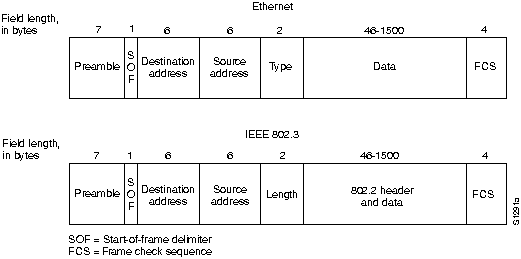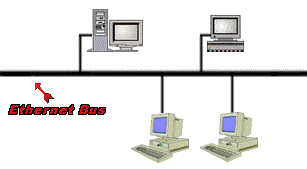Ethernet Local Area
Networks
An illustration of an Ethernet bus
General
Ethernet is, today, the de-facto hardware standard for local area networks.
Ethernet (Version 2) and the very similar IEEE 802.3 standard define the
physical and link layers of carrier sense multiple access/collision
detection (CSMA/CD) LANs. In CSMA/CD LANs, all stations can access
the network at any time. Before sending data, each station must "listen"
to the network to see if it is already in use. Data is sent only
if the station doesn't "hear" any data being sent. Collision,
is a situation where two stations detect silance on the network and send
data at the same time. To overcome collision problems, Etherenet
hardware is equipped with collision detection sensors. Whenever a
collision is detected, the colliding data is ignored, at the stations that
originally sent the data, will resend it.
Characteristics
-
Transmission speeds, cable lengths and media
Ethernet and IEEE 802.3 LANs come in a few flavours, each with it's
own length limits:
Technology
|
Data Rate (Mbps)
|
Maximum Segment Length (m)
|
Media
|
| Ethernet |
10
|
500
|
50-ohm coax (thick) |
| 10Base5 (IEEE 802.3) |
10
|
500
|
50-ohm coax (thick) |
| 10Base2 (IEEE 802.3) |
10
|
185
|
50-ohm coax (thin) |
| 1Base5 (IEEE 802.3) |
1
|
250
|
Unshielded twisted-pairwire |
| 10BaseT (IEEE 802.3) |
10
|
100
|
Unshielded twisted-pairwire |
| 10Broad36 (IEEE 802.3) |
10
|
1800
|
75-ohm coax |
-
Topology
Ethenet LANs use a bus topology, i.e. all stations are connected to
a single long cable. Any station can send a signal along the cable,
which all other stations will receive. Unlike ring topologies, the
cable doesn't close a loop.
Frame Format
Ethernet and IEEE 802.3 Frame Formats

Ethernet and IEEE 802.3 frames are similar. Both begin with an alternating
pattern of ones and zeros (the Preamable), that tells the receiving
stations that a frame is coming. Following the preamable, are the
address of the destination station and the address of the source (sending)
station.
In Ethernet frames, the 2-byte field following the source address is
a type field, used to identify the data. In IEEE 802.3 frames, the
2-byte field following the source address is a length field, which indicates
the number of bytes of data that follow this field and precede the frame
check sequence (FCS) field.
Following the type/length field is the actual data contained in the
frame, followed by a 4-byte FCS field containing a cyclic redundancy check
(CRC) value. The CRC is created by the sending device and recalculated
by the receiving device to check for damage that might have occurred to
the frame in transit.
Related topics
See Also


